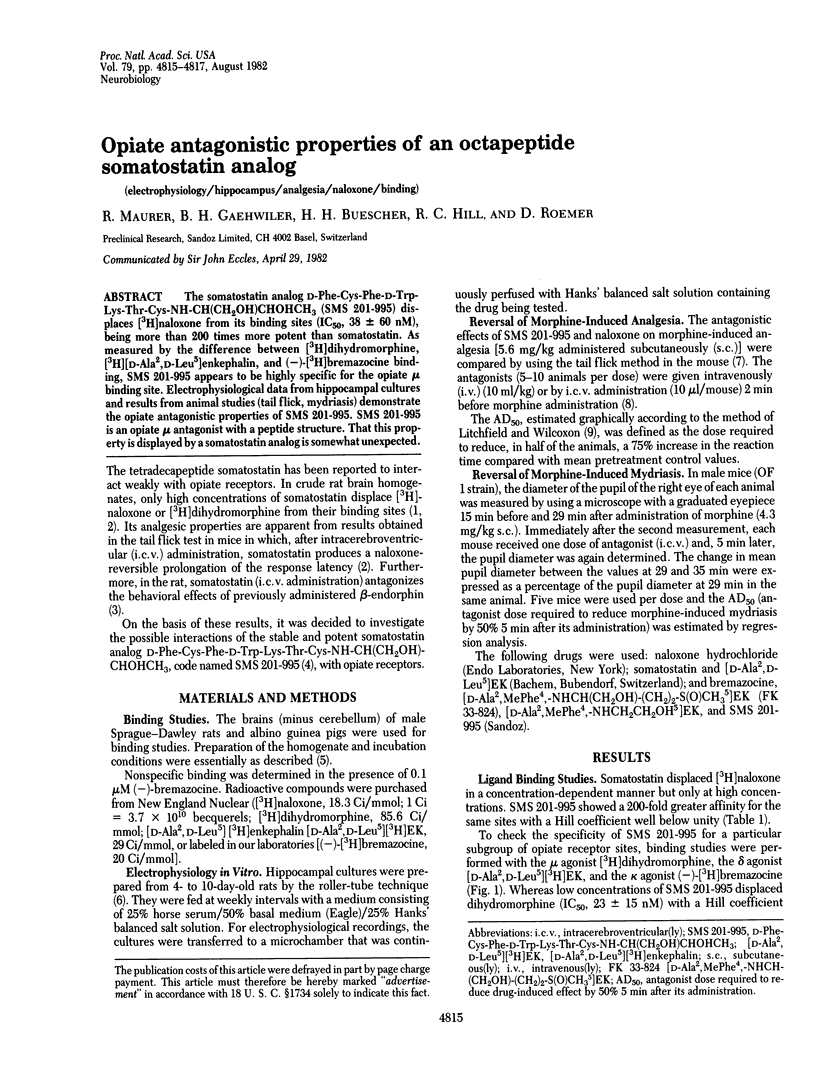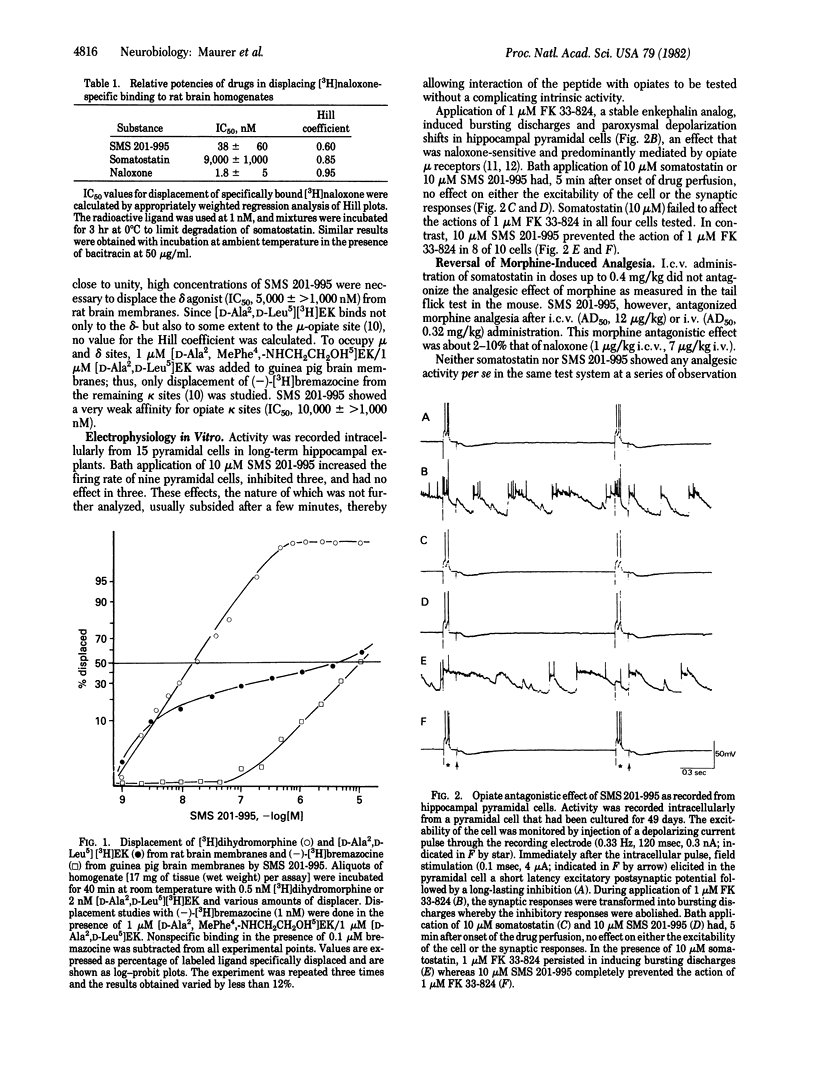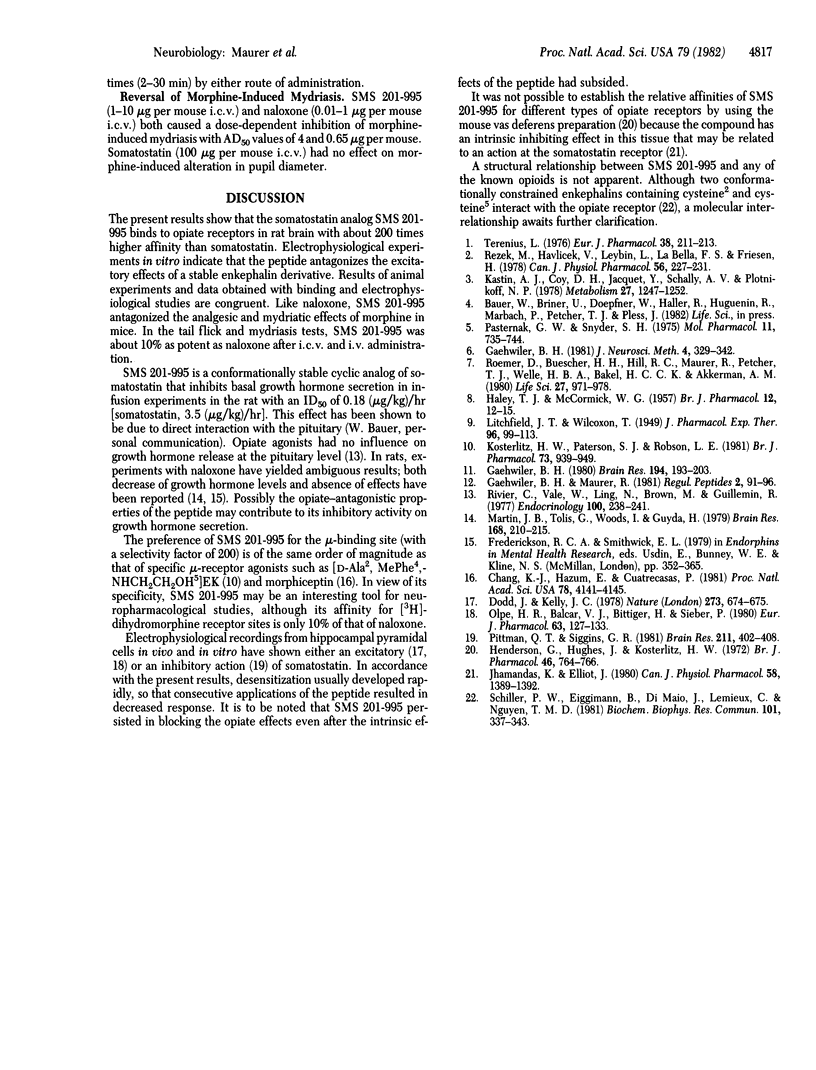Abstract
The somatostatin analog D-Phe-Cys-Phe-D-Trp-Lys-Thr-Cys-NH-CH(CH2OH)CHOHCH3 (SMS 201-995) displaces [3h[naloxone from its binding sites (IC50, 38 +/- 60 nM), being more than 200 times more potent than somatostatin. As measured by the difference between [3H]dihydromorphine, [3H][D-Ala2,D-Leu5]enkephalin, and (-)-[3H]bremazocine binding, SMS 201-995 appears to be highly specific for the opiate mu binding site. Electrophysiological data from hippocampal cultures and results from animal studies (tail flick, mydriasis) demonstrate the opiate antagonistic properties of SMS 201-995. SMS 201-995 is an opiate mu antagonist with a peptide structure. That this property is displayed by a somatostatin analog is somewhat unexpected.
Full text
PDF


Selected References
These references are in PubMed. This may not be the complete list of references from this article.
- Chang K. J., Hazum E., Cuatrecasas P. Novel opiate binding sites selective for benzomorphan drugs. Proc Natl Acad Sci U S A. 1981 Jul;78(7):4141–4145. doi: 10.1073/pnas.78.7.4141. [DOI] [PMC free article] [PubMed] [Google Scholar]
- Dodd J., Kelly S. Is somatostatin an excitatory transmitter in the hippocampus? Nature. 1978 Jun 22;273(5664):674–675. doi: 10.1038/273674a0. [DOI] [PubMed] [Google Scholar]
- Gähwiler B. H. Excitatory action of opioid peptides and opiates on cultured hippocampal pyramidal cells. Brain Res. 1980 Jul 21;194(1):193–203. doi: 10.1016/0006-8993(80)91328-1. [DOI] [PubMed] [Google Scholar]
- Gähwiler B. H., Maurer R. Involvement of mu-receptors in the opioid-induced generation of bursting discharges in hippocampal pyramidal cells. Regul Pept. 1981 May;2(2):91–96. doi: 10.1016/0167-0115(81)90003-3. [DOI] [PubMed] [Google Scholar]
- HALEY T. J., MCCORMICK W. G. Pharmacological effects produced by intracerebral injection of drugs in the conscious mouse. Br J Pharmacol Chemother. 1957 Mar;12(1):12–15. doi: 10.1111/j.1476-5381.1957.tb01354.x. [DOI] [PMC free article] [PubMed] [Google Scholar]
- Henderson G., Hughes J., Kosterlitz H. W. A new example of a morphine-sensitive neuro-effector junction: adrenergic transmission in the mouse vas deferens. Br J Pharmacol. 1972 Dec;46(4):764–766. doi: 10.1111/j.1476-5381.1972.tb06901.x. [DOI] [PMC free article] [PubMed] [Google Scholar]
- Jhamandas K., Elliott J. Comparative effects of somatostatin and enkephalins on the guinea pig ileum and the rat vas deferens. Can J Physiol Pharmacol. 1980 Nov;58(11):1389–1392. doi: 10.1139/y80-210. [DOI] [PubMed] [Google Scholar]
- Kastin A. J., Coy D. H., Jacquet Y., Schally A. V., Plotnikoff N. P. CNS effects of somatostatin. Metabolism. 1978 Sep;27(9 Suppl 1):1247–1252. doi: 10.1016/0026-0495(78)90053-7. [DOI] [PubMed] [Google Scholar]
- Kosterlitz H. W., Paterson S. J., Robson L. E. Characterization of the kappa-subtype of the opiate receptor in the guinea-pig brain. Br J Pharmacol. 1981 Aug;73(4):939–949. doi: 10.1111/j.1476-5381.1981.tb08749.x. [DOI] [PMC free article] [PubMed] [Google Scholar]
- Martin J. B., Tolis G., Woods I., Guyda H. Failure of naloxone to influence physiological growth hormone and prolactin secretion. Brain Res. 1979 May 18;168(1):210–215. doi: 10.1016/0006-8993(79)90142-2. [DOI] [PubMed] [Google Scholar]
- Olpe H. R., Balcar V. J., Bittiger H., Rink H., Sieber P. Central actions of somatostatin. Eur J Pharmacol. 1980 May 2;63(2-3):127–133. doi: 10.1016/0014-2999(80)90436-7. [DOI] [PubMed] [Google Scholar]
- Pasternak G. W., Snowman A. M., Snyder S. H. Selective enhancement of [3H]opiate agonist binding by divalent cations. Mol Pharmacol. 1975 Nov;11(6):735–744. [PubMed] [Google Scholar]
- Pittman Q. J., Siggins G. R. Somatostatin hyperpolarizes hippocampal pyramidal cells in vitro. Brain Res. 1981 Sep 28;221(2):402–408. doi: 10.1016/0006-8993(81)90791-5. [DOI] [PubMed] [Google Scholar]
- Rezek M., Havlicek V., Leybin L., LaBella F. S., Friesen H. Opiate-like naloxone-reversible actions of somatostatin given intracerebrally. Can J Physiol Pharmacol. 1978 Apr;56(2):227–231. doi: 10.1139/y78-033. [DOI] [PubMed] [Google Scholar]
- Rivier C., Vale W., Ling N., Brown M., Guillemin R. Stimulation in vivo of the secretion of prolactin and growth hormone by beta-endorphin. Endocrinology. 1977 Jan;100(1):238–241. doi: 10.1210/endo-100-1-238. [DOI] [PubMed] [Google Scholar]
- Römer D., Büscher H., Hill R. C., Maurer R., Petcher T. J., Welle H. B., Bakel H. C., Akkerman A. M. Bremazocine: a potent, long-acting opiate kappa-agonist. Life Sci. 1980 Sep 15;27(11):971–978. doi: 10.1016/0024-3205(80)90107-1. [DOI] [PubMed] [Google Scholar]
- Schiller P. W., Eggimann B., DiMaio J., Lemieux C., Nguyen T. M. Cyclic enkephalin analogs containing a cystine bridge. Biochem Biophys Res Commun. 1981 Jul 30;101(2):337–343. doi: 10.1016/0006-291x(81)91265-1. [DOI] [PubMed] [Google Scholar]
- Terenius L. Somatostatin and ACTH are peptides with partial antagonist-like selectivity for opiate receptors. Eur J Pharmacol. 1976 Jul;38(1):211–213. doi: 10.1016/0014-2999(76)90221-1. [DOI] [PubMed] [Google Scholar]


